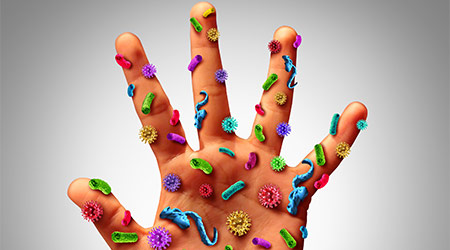
Evolving superbugs continue to threaten hospital patients and challenge environmental services (EVS) workers. But today, a growing number of antibiotic-resistant infections are occurring outside hospital walls — and jan/san distributors need to prepare themselves and their customers.
"Over the past few years, a number of infections that we always considered hospital-acquired infections, such as MRSA and C.diff, have become community-acquired infections, as well," says Shari Solomon, president of CleanHealth Environmental LLC, Silver Spring, Maryland.
Not only are superbugs becoming more resistant to antibiotic drugs, but a growing number of people are forgoing vaccinations and attending work or school when ill, thereby compounding the risk of contagion. This is especially problematic in facilities where people reside or work in close proximity.
Both inside and outside the hospital, antibiotic-resistant infections are typically spread when people touch a contaminated surface and then touch their mouth, eyes or nose, which is why handwashing and cleaning of high-touch surfaces is imperative.
"People misunderstand how different types of microorganisms are spread," says Solomon. "They're concerned about inhalation, but in reality, the majority of superbugs are contracted through contact. It goes back to hand hygiene and understanding cleaning and disinfecting protocols."
Killing Them Softly
Many species of pathogens can survive anywhere from 24 hours to weeks on hard surfaces, some in dry environments, says Heidi Wilcox, owner of Wilcox EVS Solutions in Boston. And while the focus has been on cleaning and disinfecting hard surfaces, infection control experts are finding that soft surfaces and fabrics can also play a role in transmission.
Charles Gerba, Ph.D., microbiologist and professor in Microbiology and Environmental Sciences and Public Health at the University of Arizona, Tucson, Arizona, was surprised to learn how contaminated a person can become from sitting on a couch teeming with bacteria.
"It's like a microbial whoopee cushion," he says. "When you sit down you create an aerosol, so not only do you contaminate your hands, but you can inhale microbes and get them on your clothes."
Gerba's colleague discovered this when investigating MRSA infections among firemen at the Tucson Fire Department.
"The couches they were sitting on turned out to be a reservoir of exposure to the firemen," says Gerba. "They couldn't disinfect them because the disinfectant would have made the fabric too wet."
Consequently the fire department switched to vinyl couches and over the next two years, MRSA infections were eliminated.
Gerba believes that disinfecting soft surfaces is going to be one of the challenges of the future, which is why antimicrobial fabrics are becoming more popular. Fortunately, the majority of high-touch points are hard surfaces that are easier to clean and disinfect using standard products and procedures.
Innovative Tech, Safer Disinfectants Are Tools Worth Exploring

 The Down and Dirty on Cleaning in Virus Season
The Down and Dirty on Cleaning in Virus Season How Surfactant Use is Expanding in Commercial Cleaning
How Surfactant Use is Expanding in Commercial Cleaning